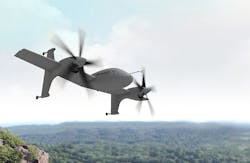Sikorsky moves forward with DARPA VTOL X-Plane project to design new military tiltrotor aircraft
Officials of the U.S. Defense Advanced Research Projects Agency (DARPA) in Arlington, Va., announced a $10 million contract to Sikorsky last week for the phase IB portion of the DARPA Vertical Take-Off and Landing Experimental Plane (VTOL X-Plane) project.
Sikorsky is one of four U.S. companies involved in the DARPA VTOL X-Plane project. The others are Aurora Flight Sciences in Manassas, Va., Karem Aircraft Inc. in Lake Forest, Calif.; and the Boeing Co. Defense, Space & Security segment in St. Louis.
All four companies won contracts earlier this year and late last year for the phase IA portion of DARPA VTOL X-Plane project. Now Sikorsky moves along to phase IB, which will include preliminary design, technology maturation, modeling and simulation, aircraft configuration, and component-level testing. For the VTOL X-Plane project Sikorsky is teaming with the Lockheed Martin Corp. Skunk Works in Palmdale, Calif.
Related: DARPA competitors vying to design fast vertical-takeoff aircraft expands to four
In the program's six-month phase IA, Sikorsky and the other three companies designed concepts for a future VTOL X-Plane, defined subsystems, identified propulsion systems, defined the layout of the aircraft, estimated aircraft performance, computed size, weight, fuel, and power requirements, and defined control systems.
For this program Sikorsky is refining the company's Unmanned Rotor Blown Wing concept -- an integration of fixed-wing aerodynamics and advanced rotor control to provide a low complexity configuration.
DARPA officials say they expect to award phase IB contracts to all four VTOL X-Plane contractors, and downselect to one contractor for the second phase of the program. DARPA reserves the option to cut contractors out of the program in a transition to phase IB if contractors fall off track.
Related: Sikorsky, Aurora Flight Sciences face off on DARPA VTOL X-Plane advanced tiltrotor project
The DARPA VTOL X-Plane initiative is a four-year $130 million effort to fly an experimental aircraft that flies faster than 300 knots with a hover efficiency of 75 percent or better and a cruise lift-to-drag ratio of 10 or more.
The VTOL X-Plane program seeks to blend technologies from fixed-wing aircraft and helicopters to enable radical improvements in vertical takeoff and hover, and fast cruise flight capabilities.
Ultimately U.S. military leaders would like to use technology developed in the DARPA VTOL X-Plane program to design a replacement for the V-22 Osprey tiltrotor, one of the first VTOL aircraft deployed with U.S. forces.
Related: Bell Helicopter debuts Bell V-280 Valor military tiltrotor
The Osprey has a top speed of 275 knots. The DARPA VTOL X-Plane project has a goal of increasing VTOL aircraft speed to at least 400 knots -- or about the cruise speed of small business jets. The VTOL X-Plane also aims at hover efficiency of at least 75 percent; cruise efficiency lift-to-drag ratio of at least 10; and useful load capacity of at least 40 percent of the vehicle’s projected gross weight of 10,000 to 12,000 pounds.
The second and third phases of the program will involve just one of the four contractors, and will involve design, development, and integration, as well as flight-test demonstrations. The first demonstration flight is set for spring 2017.
On this contract option, Sikorsky will do the work in Fort Worth, Texas; Stratford, Conn., West Palm Beach, Fla., and Palmdale, Calif., and should be finished in November 2015.
For more information contact Sikorsky Aircraft www.sikorsky.com, or DARPA at www.darpa.mil.
